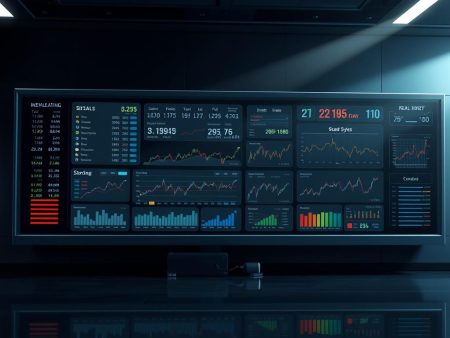Did you know that over 100 online proprietary trading firms exist today? They serve traders around the globe. This impressive number highlights the growing interest and ease of access to prop trading in finance1. But, what exactly is prop trading? And why does it matter now?
Prop trading is short for proprietary trading. Here, traders use the firm’s money to buy and sell things like stocks and options. They aim to make profits for the firm, not for clients2. This setup lets traders handle big funds without putting their money at risk. It brings huge potential rewards but also big responsibilities.
By 2024, proprietary trading is becoming more important than ever. It’s essential to know the leading firms and the latest trends. These require deep market knowledge and clever trading moves3.
Prop trading stands out for its smart strategies and vibrant industry. It demands constant learning and adaptability. This keeps traders at the cutting edge of the financial world3. So, for both experienced traders and newcomers, prop trading offers chances to explore its complex aspects.
Key Takeaways
- Over 100 online proprietary trading firms are available to traders globally1.
- Prop trading uses firm capital to trade instead of clients’ funds2.
- Traders can leverage funds without risking personal assets3.
- Continuous learning is crucial in the dynamic prop trading industry3.
- Prop trading employs advanced strategies and technologies2.
Understanding Prop Trading Definition
Prop trading means firms trade using their own money to make profits. They don’t trade for clients but for themselves. This lets them keep all the profits from their investments4. Prop trading desks work on their own and help a lot in making money for their firms. They do things that don’t involve clients’ transactions4
Prop trading is different from normal broker services because it doesn’t rely on commission. The firm gets to keep what it earns from trades5. Traders have the freedom to make fast decisions without needing a client’s okay. This makes the firm more dynamic and creative. But, it also means they face more rules and oversight. For example, the Volcker Rule stops big banks from making certain risky trades to reduce financial risks45.
After the 2008 financial crisis, people watched prop trading more closely. They saw it could make markets unstable. Rules like the Volcker Rule tried to stop risky bets that might hurt the market. But many banks say these rules go too far and have stopped prop trading5.
Still, prop trading is key for making big profits and keeping markets working well. It helps supply money for specific securities. This shows how important it is for the health of financial markets5. Prop trading stays a vital strategy for banks wanting to boost their profits each year. It shows it’s still a big deal in finance4.
What is Prop Trading?
Prop trading, or proprietary trading, involves financial firms trading with their own money. They don’t use clients’ funds. The goal is to make profits directly from the market. It’s important to understand what makes prop trading unique.
The Basics of Prop Trading
Firms give their own money to traders for larger trades. For example, if a trader makes $100,000, they could keep $40,000. The firm gets the rest. This motivates traders and benefits the firm too.
Traders have freedom but must follow risk limits6. Firms offer tech, training, and resources7. Prop trading differs from client-based trading because it only uses firm capital. This means different rewards and risks.
Key Differences Between Prop Trading and Other Trading Types
Prop trading and traditional trading differ mainly in fund source and risk7. Prop traders use the firm’s money, risking more for higher profits. They aren’t tied to investor rules or regulations7.
Traditional trading includes services like advice, but prop trading focuses on direct profits. Prop firms earn from their traders’ gains and might offer training programs6. Your trading path depends on your risk comfort and skills.
Knowing prop trading basics helps decide your trading route. Prop firms’ resources can boost your trading success.
History of Prop Trading
The story of prop trading, also called proprietary trading, is an exciting adventure that shows how modern finance grew. It started in early 20th century Wall Street. Here, people used their own money to make big profits from the market. Since then, prop trading spread all around the world, showing how the trading business changed8.
In the 1980s, the U.S. loosened financial market rules. This change led to the creation of special trading groups within banks. The era is often seen as prop trading’s golden days8. The 1990s saw new tech changing the game. This led to faster and computer-driven trading. Also, the rise of online selling helped a lot8. The financial crash in 2008 brought in new rules, like the Dodd-Frank Act. This Act aimed to stop banks from making risky bets8.
The 2010s saw independent prop firms grow as banks cut back due to new rules8. These firms work in big markets like stocks and forex. Major cities like New York and London became important places for trading8. For example, London is big for forex, while Chicago is known for commodities trading8.
Now, in the 2020s, new tech like machine learning is changing prop trading8. These firms have opened up to skilled individuals. They use only their money to make profits, though it comes with risks9. They also use smart ways to handle risks, like stop-loss limits9. With top-notch tech, high-frequency trading lets them make trades super fast9.
Prop trading’s journey shows it’s key in keeping markets running smoothly. Today, firms like E8 Funding and FTMO draw in traders with various rewards9. They keep markets moving well by offering good prices and lots of trading options9.
How Prop Trading Firms Operate
Prop trading firms use their money for trading, unlike others that manage client funds10. They rely on smart algorithms and strong risk management to make big profits.
Proprietary Capital Usage
These firms use their money to trade in many financial areas like stocks, derivatives, and Forex10. They work without client money, giving traders freedom10. This lets them make bold moves in the market.
Some top firms even let traders use a lot of market money without risk11. They charge fees for challenges and make money from memberships and teaching12.
Algorithmic Trading in Prop Firms
Algorithms are key in prop trading, offering fast and accurate trade execution. This lets prop firms make lots of trades quickly, catching market chances as they come10. Forex prop firms draw in traders with their top-notch tech for fast trading10.
High-tech trading tools and instant data are crucial for these strategies. They help traders make decisions fast and based on data10.
Risk Management Practices
Good risk management is vital for prop trading. Prop firms have tough rules to protect their money, like setting loss limits11. Futures prop trading firms focus a lot on risk control and reward careful trading10.
These steps are key to avoid big losses and keep the firm healthy. Traders must follow these rules to protect the firm’s money and aim for high earnings.
| Aspect | Description |
|---|---|
| Capital Usage | Funds are solely provided by the firm, enhancing independence in trading10 |
| Algorithmic Strategies | Algorithmic trading systems boost trade efficiency and execution speed10 |
| Risk Management | Strict guidelines on losses and performance-based structures11 |
Common Prop Trading Strategies
In proprietary trading, traders use their institution’s capital for profit. They aim to make the most of arbitrage opportunities, market-making, and financial trends.
Arbitrage Trading Explained
Arbitrage trading looks for price differences in various markets or instruments. Traders buy at a lower price in one place and sell at a higher price in another. They do this very quickly, using advanced algorithms. This method is popular because it can be quite profitable with minimal risk.
Market Making Strategy
Market-making means creating a market for securities by buying and selling them. The profit comes from the spread, the difference between buying and selling prices. Market makers bring stability and efficiency to markets. Many firms like this strategy for its steady income and the way it helps the market.
Trend Following Techniques
Trend following strategies spot and use market momentum. Traders look at past data to find trends. They decide when to enter or leave the market based on these trends. This includes News Trading and Trend Following. It also involves Scalping, Day Trading, Swing Trading, and Position Trading13.
Even though trend-following might not win as often, it’s favored for its potential to catch large price moves over time14.
Each strategy comes with its pros and cons. They also need different risk tolerance, trading methods, and experience14. Picking the right strategy is very important, especially for beginners in the competitive world of proprietary trading.
Risk Management in Prop Trading
Managing risk is key for prop trading. Traders deal with large sums, up to $400,00015. A solid risk plan helps you face sudden market changes and rate shifts16.
Spreading investments is a core strategy. It means putting money in different places and ways of trading15. Firms set rules on how much to borrow and invest to avoid big losses1517. They also use stop-loss orders to limit what they can lose and protect their money1517.
Having a good risk-to-reward strategy is crucial. Aiming for at least twice the reward for every risk taken1517. Setting targets for when to take profits helps manage finances better and supports your strategy1517. Watching risks all the time lets companies act fast if things go wrong16.
Stress tests show how money might do in bad times. This helps adjust how to manage risks1516. These methods keep trading strong against tough markets. Keeping a journal of trades tests if risk plans work well15.
Regulations Impacting Prop Trading
Prop trading firms follow strict rules to keep the market fair and traders responsible. In the United States, the U.S. Commodity Futures Trading Commission (CFTC) plays a big role. For example, the CFTC took action against My Forex Funds for running a Ponzi scheme and using clients’ money improperly. This shows how crucial rules are in overseeing prop trading18.
In Europe, rules are getting stricter under the Markets in Financial Instruments Directive (MiFID). MiFID helps make things clearer and safer for investors. It’s working on new ways to protect clients’ money, fight money laundering, and ensure firms have enough money and assets. All these efforts prove that strong financial rules are vital19.
Rules for prop trading vary greatly around the world. The European Securities and Markets Authority (ESMA) is starting to look more closely at these firms in Europe20. Yet, places like Seychelles, Mauritius, and Anguilla are attractive for their easier rules19.
Facing sudden changes in trading rules and issues with payouts, regulators are thinking of specific ways to help prop traders. These methods aim to be clear and to keep clients’ money safe. It also makes the rules more transparent. Cases like My Forex Funds stress the need for good knowledge of the rules and careful checks18.
Prop trading firms offer different challenges that come with profit-sharing, but these have different costs. The more you pay, the more you can potentially earn. This shows how different areas have their own set of rules and stresses the importance of playing by them20.
Being monitored by big names like IC Markets gives traders confidence that everything’s above board. For example, OFP prop firm being regulated by IC Markets ensures it meets all needed financial rules. This keeps the trading environment safe and legal18.
Prop Trading vs. Retail Trading
Understanding retail and prop trading differences can improve your strategies. Let’s explore what makes each unique.
Key Differences
Capital and Financial Backing: Financial firms use their money in prop trading, letting traders use more funds for possibly bigger returns21. Retail traders use their own cash on online platforms, giving them full trade control21.
Access and Resources: Prop traders get special access like threshold lists for shorting and dark pools22. Retail traders don’t need licenses. They face fewer rules but have lesser starting capital21.
Advantages and Disadvantages
Prop trading has support from institutions, more capital, and high leverage for big profits21. It comes with tight rules and stress, which could close accounts if targets are missed21.
Retail trading means no commission on stock shares and better fee options22. Yet, it has downsides like less capital, higher risk, and the need for ongoing market study21.
Both trading styles offer distinct pros and cons. Knowing them helps you navigate the markets and achieve your investment goals.
Prop Trading Jobs and Career Opportunities
Prop trading careers offer a range of exciting job roles in finance. These roles are perfect for those breaking into proprietary trading. Whether you’re an experienced trader or a tech expert, there’s a position for you.
Roles and Responsibilities
Prop trading firms are filled with critical roles and responsibilities. Key financial job roles include:
- Quantitative Analyst: They develop complex models for trading strategies.
- Software Engineer: They work on the tech needed for fast trading.
- Trader: They make trades, watch the market, and aim to make big profits.
- Risk Manager: They check risks to keep the firm’s exposure safe.
These roles require different skills and offer a mix of hard work and high earnings. Traders at top firms can keep 10-30% of their profits. Those in Churn and Burn firms might get over 50%23.
Qualifications Needed
To make it in prop trading, you need the right skills and education. Must-have qualifications include:
- Strong analytical skills and knowledge of financial markets.
- A background in finance, economics, math, or similar areas.
- Skills in programming languages like Python, C++, or Java.
- Experience with trading systems and electronic trading platforms.
Some firms may also require regulatory exams, so check what’s needed before you apply24.
Prop Trading Firm Evaluations
It’s important to look closely at prop trading firms before deciding where to work. These firms pay you based on profit splits instead of a regular salary24. Successful traders can earn a lot, from six to seven figures, or even millions each year24. Compare these key aspects:
| Criteria | Reputable Firms | Churn and Burn Firms |
|---|---|---|
| Profit Retention | 10-30% | Over 50% |
| Capital Base | Smaller than hedge funds | Usually smaller |
| Annual Returns | 100-200% | Varies a lot |
Big hedge funds like Citadel and D.E. Shaw use prop trading in their strategies23. Think about the firm’s reputation and roles offered, and make sure they fit your career goals in prop trading.
Prop Trading Salary Expectations
Considering a career in proprietary trading means knowing potential prop trading income. Entry-level traders can make $50,000 to $100,000 a year25. At the start, it’s usual for salaries to be over $80,00025
Experienced traders earn between $80,000 and $150,000. This can go even higher in big firms in major cities26. As traders grow and succeed, their pay increases. Intermediate traders might earn $102,000 a year25, while experts can take home over $165,00025.
Top traders at leading firms can earn over $1 million, especially when they manage big positions or get high returns26. Bonuses can double or triple a successful trader’s salary, boosting total pay significantly26. The financial rewards show the industry’s high risks and the intense skills needed. On average, a U.S. prop trader earns about $89,131 annually27. Some firms share a part of their profits with traders, rewarding good performance and market results27.
For a more detailed comparison, consider the following expected income levels:
| Level | Annual Salary | Bonuses | Total Compensation |
|---|---|---|---|
| Junior Prop Trader | $50,000 – $100,000 | Performance-based | Up to $150,000 or more |
| Intermediate Prop Trader | $80,000 – $150,000 | Performance-based | Up to $300,000 |
| Senior Prop Trader | $150,000+ | $200,000 – $1 million+ | $500,000 – $1 million+ |
| Top Performing Traders | $200,000+ | $500,000 – $1 million+ | $1 million+ |
Technology’s Role in Prop Trading
Technology has changed prop trading in huge ways, opening new doors to improve how trading works. Thanks to financial tech, prop firms can now use cool strategies and handle the complex trading world better. This has changed the game in how they operate and succeed.
Automated Trading Systems
Automated trading is now key in prop trading. It uses algorithms to look at market data and make trades fast, cutting down on mistakes made by people. This boosts how well firms can trade28. XTX Markets, for example, deals with over 120 billion quotes each day, showing how powerful these tools are in the industry29. This highlights why automated systems are so important for staying ahead.
Machine Learning and AI
Adding AI into trading has really shaken things up. Companies like Two Sigma and Renaissance Technologies use AI and ML to predict market moves and get ahead29. They analyze how people feel about the market using news and social media, helping them make smarter trades28. AI makes trading strategies much better, improving both accuracy and profits.
Low-Latency Trading Infrastructure
Quick and reliable trading infrastructure is crucial in prop trading. Using cloud platforms like AWS and Microsoft Azure, firms can grow easily and handle more data without a hitch29. This way, trades happen super fast, grabbing opportunities that could be missed otherwise. Plus, these tech advancements help manage risks and boost trading performance28.
Challenges and Risks in Prop Trading
Prop trading brings unique challenges and risks. One of the main risks is the high volatility of cryptocurrencies. Quick price changes in digital assets demand strong risk management strategies. Traders face big losses during unexpected economic events or when central banks step in30.
Regulatory compliance is another big challenge. Financial regulation changes can mess up trading strategies. It could also stop a firm from taking some risks. This makes the market tough31. Prop trading firms must also follow rules for algorithmic trading. Following these rules is key for smooth trading32.
Cybersecurity is a big concern in prop trading. With the rise of advanced technology, firms must protect their data and algorithms. Investing in cybersecurity is essential to prevent hacking.
Market liquidity issues are another challenge. During low liquidity, executing trades can be hard without impacting market prices. The Swiss Franc crisis in 2015 showed how bad this can be30.
Mental and emotional stress is common among prop traders. Making quick decisions in a fast market is hard. Traders need to stay calm and control their emotions31.
To deal with these risks, prop firms use strict risk management. They set drawdown limits and follow performance metrics. This helps balance risk with the chance of profit32.
Future of Prop Trading
The future of prop trading looks bright as markets change. New technologies and changing market trends open up great chances for these firms. They’re set to make the most of new finance opportunities.
Emerging Opportunities
Prop trading creates special chances for firms and traders. For example, companies like FTMO and Apex Trader Funding offer various account sizes. They have profit splits that help traders grow their earnings. FTMO gives traders options from $10,000 to $400,000 with up to 90% profit splits33. This approach helps bring in talented traders from all over the globe34.
Technological Advancements
AI, machine learning, and automation are changing trading. These technologies let prop firms analyze data fast and accurately33. Also, blockchain and crypto trading bring new chances. They offer the volatility and liquidity these firms are looking for33. These tech improvements help firms stay ahead in the fast-paced finance world.
Market Dynamics
Market trends are always moving because of global economics and geopolitical risks. These changes affect market volatility and trading chances33. Also, prop trading’s future changes with new regulations. Firms need strong compliance plans to keep up33. Being flexible and diverse remains essential as firms adapt34. Forex Brokers join prop trading to spread risk and diversify, showing the strength of this business model34.
To be leaders, prop trading firms must always look for new market chances. They need to adapt to keep defining the future of finance. To learn more, check out this in-depth analysis.
Conclusion
Prop trading has grown into an important part of the finance world. It uses its own money to make bold moves in the market35. Banks and trading firms use strategies like arbitrage and fast trading to make profits. The use of algorithms and AI has made trading more efficient36.
Prop trading is risky but offers chances for big rewards. Firms provide tools and support for those wanting to succeed in this area35. The rise of crypto trading firms shows how prop trading is changing and growing36.
Knowing the good and bad of prop trading is key for anyone interested. It promises high earnings and the chance to trade in different markets using new strategies37. If you want to learn more about prop trading, check out this guide35.



